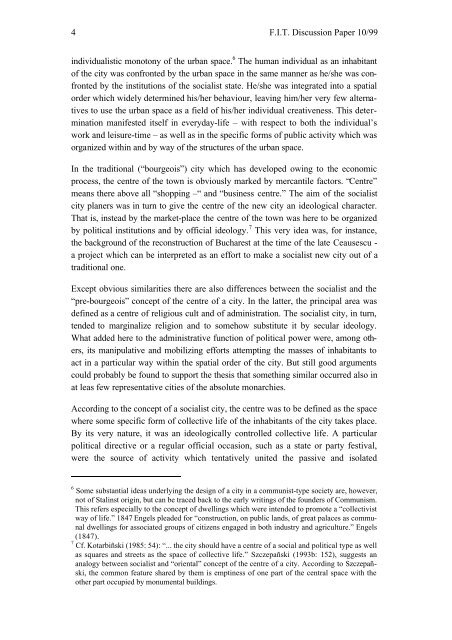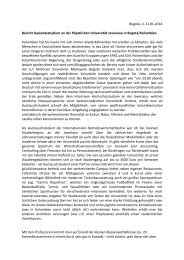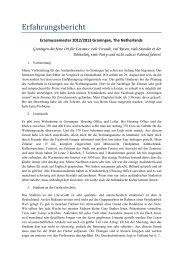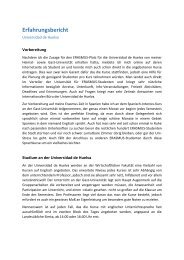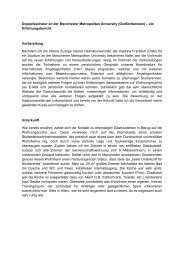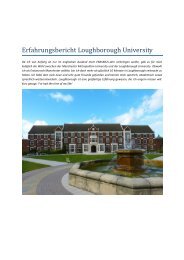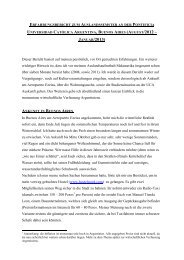Dariusz Aleksandrowicz Aleksandrowicz - Europa-Universität ...
Dariusz Aleksandrowicz Aleksandrowicz - Europa-Universität ...
Dariusz Aleksandrowicz Aleksandrowicz - Europa-Universität ...
You also want an ePaper? Increase the reach of your titles
YUMPU automatically turns print PDFs into web optimized ePapers that Google loves.
4 F.I.T. Discussion Paper 10/99<br />
individualistic monotony of the urban space. 6 The human individual as an inhabitant<br />
of the city was confronted by the urban space in the same manner as he/she was confronted<br />
by the institutions of the socialist state. He/she was integrated into a spatial<br />
order which widely determined his/her behaviour, leaving him/her very few alternatives<br />
to use the urban space as a field of his/her individual creativeness. This determination<br />
manifested itself in everyday-life – with respect to both the individual’s<br />
work and leisure-time – as well as in the specific forms of public activity which was<br />
organized within and by way of the structures of the urban space.<br />
In the traditional (“bourgeois”) city which has developed owing to the economic<br />
process, the centre of the town is obviously marked by mercantile factors. “Centre”<br />
means there above all “shopping –“ and “business centre.” The aim of the socialist<br />
city planers was in turn to give the centre of the new city an ideological character.<br />
That is, instead by the market-place the centre of the town was here to be organized<br />
by political institutions and by official ideology. 7 This very idea was, for instance,<br />
the background of the reconstruction of Bucharest at the time of the late Ceausescu -<br />
a project which can be interpreted as an effort to make a socialist new city out of a<br />
traditional one.<br />
Except obvious similarities there are also differences between the socialist and the<br />
“pre-bourgeois” concept of the centre of a city. In the latter, the principal area was<br />
defined as a centre of religious cult and of administration. The socialist city, in turn,<br />
tended to marginalize religion and to somehow substitute it by secular ideology.<br />
What added here to the administrative function of political power were, among others,<br />
its manipulative and mobilizing efforts attempting the masses of inhabitants to<br />
act in a particular way within the spatial order of the city. But still good arguments<br />
could probably be found to support the thesis that something similar occurred also in<br />
at leas few representative cities of the absolute monarchies.<br />
According to the concept of a socialist city, the centre was to be defined as the space<br />
where some specific form of collective life of the inhabitants of the city takes place.<br />
By its very nature, it was an ideologically controlled collective life. A particular<br />
political directive or a regular official occasion, such as a state or party festival,<br />
were the source of activity which tentatively united the passive and isolated<br />
6 Some substantial ideas underlying the design of a city in a communist-type society are, however,<br />
not of Stalinst origin, but can be traced back to the early writings of the founders of Communism.<br />
This refers especially to the concept of dwellings which were intended to promote a “collectivist<br />
way of life.” 1847 Engels pleaded for “construction, on public lands, of great palaces as communal<br />
dwellings for associated groups of citizens engaged in both industry and agriculture.” Engels<br />
(1847).<br />
7 Cf. Kotarbiñski (1985: 54): “... the city should have a centre of a social and political type as well<br />
as squares and streets as the space of collective life.” Szczepañski (1993b: 152), suggests an<br />
analogy between socialist and “oriental” concept of the centre of a city. According to Szczepañski,<br />
the common feature shared by them is emptiness of one part of the central space with the<br />
other part occupied by monumental buildings.


